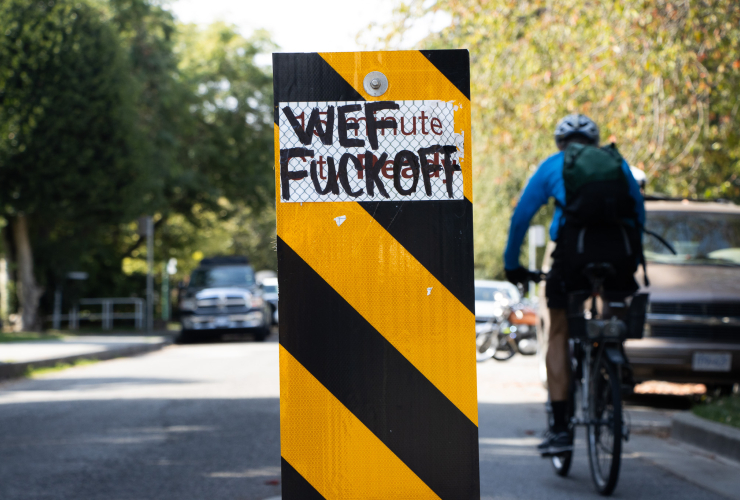Support journalism that lights the way through the climate crisis
In mid-August, Jennifer Jesty was awoken at 5 a.m. by a call from the RCMP detachment in Eskasoni, a Mi’kmaq community on the shores of the rich saltwater Bras d'Or Lake in Nova Scotia.
Groggily, she answered.
The officer asked her to do something she’d been waiting years to hear: send out an alert about an ongoing incident using the Unama’ki Emergency Alert System.
This was a first for Jesty, emergency resilience manager for the Union of Nova Scotia Mi’kmaq, member of the Eskasoni First Nation and creator of the alert system.
Since launching on Sept. 1, 2020, approximately 64 per cent of the population of the five Mi'kmaq communities it serves have subscribed to the emergency alert system.
A total of 167 alerts have been sent out, informing communities of incidents such as missing persons, increased police presence, incoming hurricanes and dangerous individuals.
Unama’ki Emergency Alert System’s subscriber-based model is just one of the many ways it differs from Canada’s National Public Alerting System, otherwise known as Alert Ready.
Subscribers can choose how they receive an alert — text message, email or landline. And they can opt to receive alerts for more than one community if they have loved ones living elsewhere, Jesty said.
The criteria for sending out an alert is up to the sender, a chief, community leader or Jesty. A text-only option was recently added to avoid waking people with a call to their landline if the alert doesn’t warrant that amount of urgency.
Jesty is particularly proud of the voice-to-text tool that allows alert senders to dictate alerts in their own language.
“We're talking about critical incident language and you want to make sure there's no barrier there when it comes to language,” she said.
After the early morning call from RCMP, Jesty sent out an initial alert to the First Nation communities in Cape Breton affected by the reported stabbing and followed it up with three subsequent alerts.
“I really made a big deal to the RCMP officers that were phoning me and talking to me through this incident by saying ‘This is huge,’” she said.
Jesty said she wanted to prove to police they could use the Unama’ki Emergency Alert System to keep the communities calm and informed, without compromising their investigation.
“I just hope that it continues like that,” she said.
But the RCMP has been slow to co-operate, according to Jesty. And this summer, as extreme weather such as fires and floods wreaked havoc across much of Nova Scotia, Jesty’s frustration reached a boiling point. She said watching people receive alerts late, if at all, during events such as the fatal flash flooding in West Hants and the Upper Tantallon wildfire was disheartening.
“I was losing my mind on many levels,” Jesty said. “Primarily because I am sitting here with this alert system that is wildly successful, that is easy to use and set up. And nobody's listening to me.”
Despite its success and Jesty’s efforts to spread the word, the Unama’ki system has only been adopted by one other community in Canada: Lennox Island First Nation on Prince Edward Island. Now, she wants to prove to the rest of Canada that they can keep their communities safe using this alert system. All they have to do is take her up on her offer.
‘It's not a better way, it's just another way’
Annie Bernard-Daisley of the We’koqma’q First Nation is a mother and a chief.
Most of the time, the distinction between those two roles isn’t a difficult one for her to make. But, about a year ago, when her nine-year-old daughter went missing, the lines blurred.
“I almost lost my mind. I couldn't find my daughter for about two hours,” she said. “All I could think was, ‘Here I am, as a mom, trying to distinguish between being a mom and a chief.’”
That’s when Jesty stepped in to issue a missing child alert using the Unama’ki system.
Amid recent calls before Parliament to have a system dedicated solely to alerts on missing Indigenous women and girls, Bernard-Daisley said Jesty’s system is making a difference in locating missing Indigenous people around Cape Breton.
According to the National Inquiry into Missing and Murdered Indigenous Women and Girls in 2019, Indigenous women, girls and 2SLGBTQQIA+ people are 12 times more likely to go missing or be murdered than non-Indigenous women — and that doesn’t account for all the unreported or misreported cases.
Using her system, Jesty said 49 people have been reunited with their loved ones after an alert was sent out.
One of those 49 was Bernard-Daisley’s daughter.
“She was only across the road, but she was only nine and it was totally unlike her, so we had to send out an alert,” Bernard-Daisley said. “Within minutes, she was found.”
As an advanced care paramedic and the first Indigenous woman to become a member of the Nova Scotia Firefighters Association, Jesty has always been a “boots on the ground” person in an emergency situation.

From creating educational posters to tabling at the band office so people could sign up using a pen and paper, Jesty said she made every effort to inform communities of the Unama’ki system when it launched.
She also sent summer students door-to-door to elders’ houses to explain the system.
“I even wrote them a script because you might describe it differently than I do, and I couldn't have that,” she said. “I needed to make sure the message was consistent.”
Not one person declined to receive alerts from Jesty’s new system.
To issue an alert, a chief or community leader must enter a username, password and message body and then hit send. There’s no specific ringtone associated with the alerts yet, but Jesty said she’s working on an educational video to teach subscribers how to change the settings of their phone so they hear a specific noise when an alert comes in.
Jesty is one of a handful of leaders, including Bernard-Daisley, across five Mi’kmaq communities who have the authority to issue such alerts using the Unama’ki system.
“It's made for us, by one of us,” said Bernard-Daisley.
This is a rare example in Canada of First Nations having direct access to a mass notification system.
Using Alert Ready, Alberta and Saskatchewan are the only two provinces that allow First Nations direct access to issue alerts.
Everywhere else in Canada, First Nations leaders must go through emergency management officials from other governments if they wish to issue an alert through that system.
Meanwhile, Jesty said her subscriber numbers continue to rise.
On June 21, the Standing Committee on Indigenous and Northern Affairs (INAN) presented a report to the House of Commons filled with recommendations to the federal government about emergency preparedness in Indigenous communities.
One recommended evaluating how emergency alert systems can be implemented in Indigenous communities to meet their needs.
In her ideal world, Jesty said her system would co-exist alongside other alert systems in Canada. The goal isn’t to replace one system with another, she pointed out, since her subscriber-based system wouldn’t necessarily work well for tourists visiting an area.
But she said there’s room for it to expand into other First Nations across Canada — and it doesn’t have to cost a pretty penny.
In the same report, the INAN committee recommends the federal government provide funding to Indigenous communities to aid the development of culturally appropriate emergency response services.
The Unama’ki Emergency Alert System is funded by Indigenous Services Canada and Jesty said in her experience, Indigenous Services has shown a willingness to accept all applications it received for funding for alert systems.
For the past three years, Jesty has presented her system to other First Nations across the country, showed them how to submit applications for funding to ease financial pressure and emailed them folders full of educational posters.
“The main takeaway message that I'm trying to convey to everyone is: there is another way,” she said. “It's not a better way, it's just another way.”
As climate change continues to increase the frequency and intensity of extreme weather, which disproportionately impacts Indigenous people, and colonization continues to contribute to the ongoing genocide of Indigenous women and girls, Jesty is seeking more collaborators on her system.
Whether it’s First Nations or entire municipalities, she said the Unama’ki alert system’s subscription requirement allows for unique, community-specific alerts.
“This is so easy that we could set it up in every town, every community, every Indigenous community across this country within an hour … and nobody's listening,” she said.
“We have a solution, why don't you want it?”
This story was produced in partnership with the Climate Disaster Project, an international teaching newsroom co-ordinated at the University of Victoria, and participating reporters and editors at Carleton University in Ottawa.






Comments